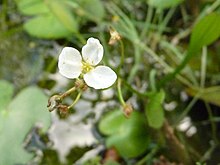Sagittaria pygmaea, commonly known as the dwarf arrowhead or pygmy arrowhead,[2] is an aquatic plant species. It is a perennial herb producing by means of stolons. Leaves are linear to slightly spatula-shaped, not lobed, up to 30 centimetres (12 inches) long.[3][4][5]
| Sagittaria pygmaea | |
|---|---|

| |
| Scientific classification | |
| Kingdom: | Plantae |
| Clade: | Tracheophytes |
| Clade: | Angiosperms |
| Clade: | Monocots |
| Order: | Alismatales |
| Family: | Alismataceae |
| Genus: | Sagittaria |
| Species: | S. pygmaea
|
| Binomial name | |
| Sagittaria pygmaea | |
| Synonyms[1] | |
| |
It is native to Japan (including the Ryukyu Islands), Korea, Taiwan, Thailand, Vietnam, Bhutan and China (Anhui, Fujian, Guangdong, Guangxi, Guizhou, Hainan, Henan, Hubei, Hunan, Jiangsu, Jiangxi, Shaanxi, Shandong, Sichuan, Yunnan, Zhejiang).[1][3] It grows in shallow water in marshes, channels and rice paddies.
References
edit- ^ a b c "Sagittaria pygmaea". World Checklist of Selected Plant Families (WCSP). Royal Botanic Gardens, Kew. Retrieved 2017-01-30.
- ^ "Sagittaria pygmaea". Germplasm Resources Information Network. Agricultural Research Service, United States Department of Agriculture. Retrieved 2017-02-09.
- ^ a b "Sagittaria pygmaea in Flora of China @ efloras.org". www.efloras.org. Retrieved 2017-01-30.
- ^ Gakkai, Nihon Shokubutsu; Gakkai, Tåokyåo Shokubutsu; Gakkai, Tokyo Shokubutsu (1902-01-01). "The Botanical Magazine". Botanical Magazine Tokyo. v.16 (1902). ISSN 0006-808X.
- ^ Nakai, Takenoshin (1943). Journal of Japanese Botany. [Shokubutsu Kenkyu Zasshi]. Tokyo 19:247. "Blyxa coreana".